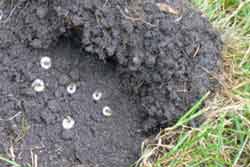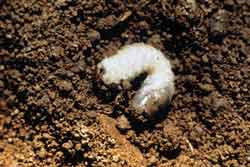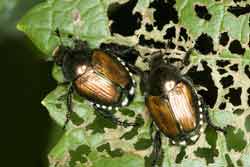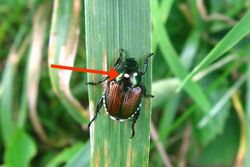Japanese Beetle—Popillia japonica
The Japanese beetle is a highly destructive plant pest. Feeding on grass roots, Japanese beetle grubs damage lawns, golf courses, and pastures. Japanese beetle adults attack the foliage, flowers, or fruits of more than 300 different ornamental and agricultural plants.
See also White Grubs
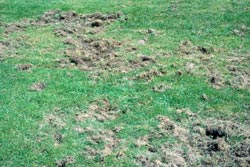
Early indications of grub infestation are irregular patches of dry grass, flocking birds, or entire areas of turf being torn up by raccoons, possums and skunks looking for a tasty treat.
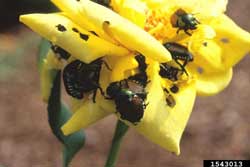
Adult Japanese beetles are 7/16-inch long metallic green beetles with copper-brown wing covers. A row of white tufts (spots) of hair project from under the wing covers on each side of the body. Roses are highly susceptible to Japanese beetles.
Click on images to view full-size
Identification and Control Information
- Japanese Beetles in the Urban Landscape (PDF)—University of Kentucky Cooperative Extension
- Pest Management Fact Sheet: Japanese Beetle—University of Maine Cooperative Extension
- Managing the Japanese Beetle: A Homeowner's Handbook (PDF)—United States Department of Agriculture
- Control of Japanese Beetle Adults and Grubs in Home Lawns (PDF)—Ohio State University Extension
- Tips for Managing Japanese Beetles (PDF)—Maine Integrated Pest Management Council
- Beetles on Ornamental Plants (PDF)—University of New Hampshire Cooperative Extension
- How to Get Rid of Japanese Beetles—University of Maine Cooperative Extension
- Grubs Got Your Lawn? Before You Act Please Read This! - Maine YardScaping Partnership
More Information
- The Fly that Attacks Japanese Beetles - Laidback Gardener
- Japanese Beetle: The Continuing Struggle to Achieve Successful Biological Control—Midwest Biological Control News
- Relative Susceptibility of Woody Landscape Plants to Japanese Beetle (PDF)—Journal of Arboriculture November 2004
- Using Beneficial Nematodes for Grub Control—Yardscaping
- Does Milky Spore Disease Work? (PDF)—Cornell University Turfgrass Times
- Milky Spore Disease—University of Illinois Extension
- Biological Control: Paenibacullus popilliae, Milky Disease—Cornell University College of Agriculture and Life Sciences Department of Entomology
[Photos, left to right: M.G. Klein, USDA Agricultural Research Service, Bugwood.org; unknown; Jim Baker, North Carolina State University, Bugwood.org; Jim Baker, North Carolina State University, Bugwood.org; David Cappaert, Michigan State University, Bugwood.org; unknown]
